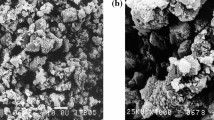Abstract
The mechanical dehydration method is generally used for reducing the moisture content in sludge. However, there is little understanding of the physical and mechanical properties and dehydration mechanism of sludge during pressurization. In this paper, characteristics of sludge were studied from the perspective of soil mechanics. The water permeability, loading conditions, and dehydration performance of the sludge during the pressurization process were analyzed through a series of geotechnical laboratory experiments. The results showed that the pore structure, compressibility coefficient, consolidation coefficient, and permeability coefficient of the sludge are related to the dehydration rate. The conditioners that mixed with sludge could increase the dewatering rate by reducing the sludge viscosity, changing the water status, and increasing the permeability coefficient. The two conditioners used in this study increased the dehydration rate of the sludge from 27.5 to 52.6% and 63.9%, respectively. Unlike the seepage consolidation of ordinary clay, which has only one stage, the seepage consolidation of sludge could be divided into three stages. The removed water in the first stage is mainly free water; the discharge in the second stage is the combination of free water and bound water, and bound water was mainly discharged in the third stage. The water content at the end of each stage corresponds to the liquid limit, plastic limit, and shrinkage limit of the sludge. Our study provides a novel insight for understanding the deep dewatering of sludge and is benefit to solve the problem of sludge dewatering.





Similar content being viewed by others
References
Central Politburo Standing Committee of the Communist Party of China (2015) Action Plan for Prevention and Control of Water Pollution
Chen DD, Dou LH, Lu P, Huang YJ, Zhou J (2019) A review on sludge deep dewatering technology. Chem Ind Eng Progress 38(10):4722–4746
China Academy of Building Research (2011) Code for the Design of Building Foundations (GB 50007—2011)
China Environmental Online (2018) The attention of the state is increasing, and sludge treatment and disposal are stepping into the fast lane. http://www.hbzhan.com/News/detail/125144.html
Elliot A, Mahmood T (2007) Pretreatment technologies for advancing anaerobic digestion of pulp and paper biotreatment residues. Water Res 41:4273–4286
Fan XH, Zhu W, Wang AW, Xu HQ, Shu S (2016) Experimental study on consolidation-permeability properties and pore size variation during consolidation. J Southeast Univ 43(46):20–24
GEP Research (2018) Research Report on the development of sludge treatment and disposal industry in the world and China (2018)
He DQ, Wang LF, Jiang H, Yu HQ (2015) A Fenton-like process for the enhanced activated sludge dewatering. Chem Eng J 20(14):128–134
Li J, Plougonven E, Fraikin L, Salmon T, Toye D, Nistajakis E, Léonard A (2015) Multiscale structure characterization of sawdust-wastewater sludge extrudates dried in a pilot-scale fixed bed. Biomass Bioenerg 81:98–107
Lin F, Zhu XL, Lin JG, Yu PR, Luo Y, Liu MR (2019) Effect of extracellular polymeric substance(EPS) conditioned by combined lysozyme and cationic polyacrylamide on the dewatering performance of activated sludge. Chemosphere 235:679–689
Liu DM (2012) The development of sludge treatment technology in the world. Water Waste Water Inf 03:41–43
Liu H, Shi JS, Xu XY, Zhan XM, Fu B, Li YF (2017) Enhancement of sludge dewaterability with filamentous fungi talaromyces flavus S1 by depletion of extracellular polymeric substances or mycelium entrapment. Biores Technol 245:977–983
Ma R, Wu LJ, Ren RP, Lyu YK (2019) Research progress on rheological properties of evaluating sludge dewaterability in wastewater treatment plan. Appl Chem Ind 5:1–8
Maria R-H, Guillermo M-E, Labanda J, Llorens J (2013) Dewaterability of sewage sludge by ultrasonic, thermal and chemical treatment. Chem Eng J 230:102–110
Ministry of Water Resources the People’s Republic of China (1999) Standard for Soil Test Method (GB/T 50123—1999)
Nittami T, Uematsu K, Nabatame R, Kondo K, Takeda M, Matsumoto K (2015) Effect of compressibility of synthetic fibers as conditioning materials on dewatering of activated sludge. Chem Eng J 268:86–91
Nowak O (2006) Optimizing the use of sludge treatment facilities at municipal WWTPs. J Environ Sci Health 41(9):1807–1817
Ras M, Girbal-Nauhauser E, Paule E, Sperandio M, Lefebvre D (2008) Protein extraction from activated sludge: an analytical approach. Water Res 42(9):1867–1878
Thapa KB, Qi Y, Clayton SA, Hoadely AFA (2009) Lignite aided dewatering of digested sewage sludge. Water Res 4(3):623–634
The State Council of People’s Republic of China (2016) The 13th five-year plan for protection of ecological environmental
Wang CX, Zhang WJ, Wang DS, Wang QF, Yu DZ (2016) Influencing mechanism of titanium salt coagulant chemical conditioning on thephysical and chemical properties of activated sludge flocs. Environ Sci 37(6):2243–2251
Zhang JS, Xue YG, Eshtiaghi N, Dai XH, Tao WQ, Li Z (2017) Evaluation of thermal hydrolysis efficiency of mechanically dewatered sewage sludge via rheological measurement. Water Res 116:34–43
Zhang J, Hu Q, Lu J, Lin H (2019a) Study on the effect of chitosan conditioning on sludge dewatering. Water Sci Technol 79(3):501–509
Zhang XC, Kang HS, Zhang QR, Hao XM, Han X, Zhang W, Jiao TF (2019b) The porous structure effects of skeleton builders in sustainable sludge dewatering process. J Environ Manag 230:14–20
Acknowledgements
This research did not receive any specific grant from funding agencies in the public, commercial, or not-for-profit sectors.
Author information
Authors and Affiliations
Corresponding author
Ethics declarations
Conflict of interest
The authors declare no conflict of interest.
Additional information
Editorial responsibility: Binbin Huang.
Rights and permissions
About this article
Cite this article
Xiaochun, Z., Yao, F. & Ying, H. Effect of permeability and loading conditions on dehydration of sludge in its pressurization process. Int. J. Environ. Sci. Technol. 18, 2295–2302 (2021). https://doi.org/10.1007/s13762-020-02959-8
Received:
Revised:
Accepted:
Published:
Issue Date:
DOI: https://doi.org/10.1007/s13762-020-02959-8




